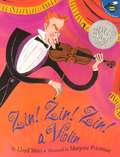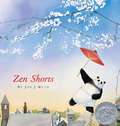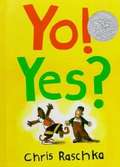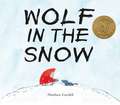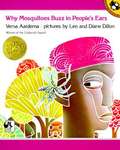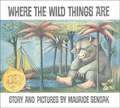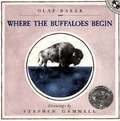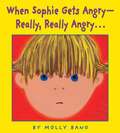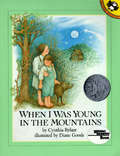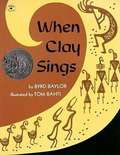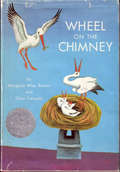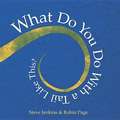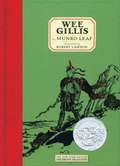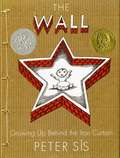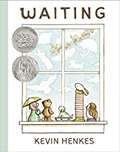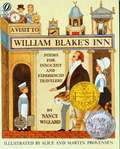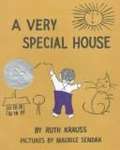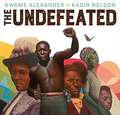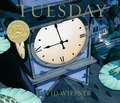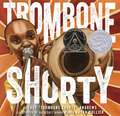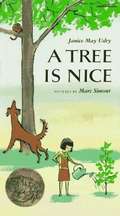Special Collections
Caldecott Award Winners
- Table View
- List View
Zin! Zin! Zin! A Violin
by Lloyd MossUsing evocative poetic language, the author describes ten instruments coming on stage and performing, to the delight of the audience. [This text is listed as an example that meets Common Core Standards in English language arts for K-1 at http://www.corestandards.org.]
Zen Shorts
by Jon Muth"Michael," said Karl. "There's a really big bear in the backyard." This is how three children meet Stillwater, a giant panda who moves into the neighborhood and tells amazing tales. To Addy he tells a story about the value of material goods. To Michael he pushes the boundaries of good and bad. And to Karl he demonstrates what it means to hold on to frustration. With graceful art and simple stories that are filled with love and enlightenment, Jon Muth--and Stillwater the bear--present three ancient Zen tales that are sure to strike a chord in everyone they touch.
Yo! Yes?
by Chris RaschkaRaschka's Caldecott Honor Book which captures the street poetry between two boys is now available for the first time in a Scholastic Bookshelf paperback version. Full color.
Working Cotton
by Sherley Anne WilliamsA young black girl relates the daily events of her family's migrant life in the cotton fields of central California.
Why Mosquitoes Buzz in People's Ears
by Verna AardemaWhen Mosquito tells iguana a terrible lie, he sets off a chain of events. Owl will not wake the sun, so there is not sunrise. Find out what happens in this West-African tale and find out why mosquitos buzz in people's ears. Winner of the 1976 Caldecott Medal for best picture book.
Where the Wild Things Are
by Maurice SendakWinner of the 1964 Caldecott Medal for the Most Distinguished Picture Book of the Year, Where the Wild Things Are became an iconic book that has inspired a movie, an opera, and the imagination of generations. It continues to be one of the best loved books of all time the world over, by the one and only Maurice Sendak. Supports the Common Core State Standards. Images and image descriptions available.
Where the Buffaloes Begin
by Olaf BakerFollow Little Wolf to the fabled lake in the south where the buffaloes begin. Watch the huge beasts surge out of the water and onto the prairie, as Little Wolf leads them to a victory against the enemies of his people. A Caldecott Honor Book. Illustrations in black-and-white. Copyright © Libri GmbH. All rights reserved.
When Sophie Gets Angry - Really, Really Angry
by Molly BangSophie gets mad, climbs a tree to calm down, and is soon ready to come home to her loving family. "The text is. . . brief, for it is Bang's double-page illustrations, vibrating with saturated colors, that reveal the drama of the child's emotions. " - School Library Journal, starred review. "Bang's strong, nonproscriptive acknowledgment of a feeling most children will recognize will be welcomed. " - Booklist, starred review
Winner of the Caldecott Honor
When I was Young in the Mountains
by Cynthia RylantA story about the childhood reminiscences of growing up in the Appalachian Mountains & the pleasures in life.
When Clay Sings
by Byrd BaylorBased on the original pottery of the ancient Anasazi, Mogollon, Hohokam and Mimbres cultures, the writer imagines the reasons for the making of the pottery and its creation.
A beautifully-illustrated prose poem for preschool through grade 3 and older readers. These few words convey much about the role of pottery in the Southwestern Native-American culture.
Winner of the Caldecott Honor
Wheel on the Chimney
by Margaret Wise BrownA story about storks and their home on the wheel of a chimney.
What Do You Say, Dear?
by Sesyle JoslinA handbook of etiquette for young ladies and gentlemen to be used as a guide for everyday social behavior. For very small children.
What Do You Do With a Tail Like This?
by Steve JenkinsA nose for digging? Ears for seeing? Eyes that squirt blood? Explore the many amazing things animals can do with their ears, eyes, mouths, noses, feet, and tails in this beautifully illustrated interactive guessing book by Steve Jenkins and Robin Page.
Winner of the Caldecott Honor
Wee Gillis
by Robert Lawson and Munro LeafA Caldecott Honor Book by the creators of the beloved Story of Ferdinand; Wee Gillis lives in Scotland. He is an orphan, and he spends half of each year with his mother's people in the lowlands, while the other half finds him in the highlands with his father's kin. Both sides of Gillis's family are eager for him to settle down and adopt their ways. In the lowlands, he is taught to herd cattle, learning how to call them to him in even the heaviest of evening fogs. In the rocky highlands, he stalks stags from outcrop to outcrop, holding his breath so as not to make a sound. Wee Gillis is a quick study, and he soon picks up what his elders can teach him. And yet he is unprepared when the day comes for him to decide, once and for all, whether it will be the lowlands or the highlands that he will call his home. Robert Lawson and Munro Leaf's classic picture book is a tribute to the powers of the imagination...
We Are Water Protectors
by Carole LindstromInspired by the many Indigenous-led movements across North America, We Are Water Protectors issues an urgent rallying cry to safeguard the Earth’s water from harm and corruption―a bold and lyrical picture book written by Carole Lindstrom and vibrantly illustrated by Michaela Goade. Water is the first medicine. It affects and connects us all . . . When a black snake threatens to destroy the Earth And poison her people’s water, one young water protector Takes a stand to defend Earth’s most sacred resource.
Watercress
by Jason Chin and Andrea WangCaldecott Medal Winner, Newbery Honor Book, APALA Award Winner
A story about the power of sharing memories—including the painful ones—and the way our heritage stays with and shapes us, even when we don’t see it.
While driving through Ohio in an old Pontiac, a young girl's Chinese immigrant parents spot watercress growing wild in a ditch by the side of the road. They stop the car, grabbing rusty scissors and an old paper bag, and the whole family wades into the mud to gather as much as they can. At first, she's embarrassed. Why can't her family just get food from the grocery store, like everyone else? But when her mother shares a bittersweet story of her family history in China, the girl learns to appreciate the fresh food they foraged—and the memories left behind in pursuit of a new life.
Together, they make a new memory of watercress.
Author Andrea Wang calls this moving, autobiographical story “both an apology and a love letter to my parents.” It’s a bittersweet, delicate look at how sharing the difficult parts of our histories can create powerful new moments of family history, and help connect us to our roots. Jason Chin’s illustrations move between China and the American Midwest and were created with a mixture of traditional Chinese brushes and western media. The dreamy, nostalgic color palette brings this beautiful story to life. An endnote from the author describes her personal connection to the story, and an illustrator’s note touches on both the process of the painting, and the emotional meaning brought to the work.
The Wall
by Peter SísThrough journals, maps, and dreamscapes, Peter Sís shows what life was like for a child who loved to draw, proudly wore the red scarf of a Young Pioneer, stood guard at the giant statue of Stalin, and believed whatever he was told to believe. But adolescence brought questions. Cracks began to appear in the Iron Curtain, and news from the West slowly filtered into the country. Sís learned about beat poetry, rock 'n' roll, blue jeans, and Coca-Cola. He let his hair grow long, secretly read banned books, and joined a rock band. Then came the Prague Spring of 1968, and for a teenager who wanted to see the world and meet the Beatles, this was a magical time. It was short-lived, however, brought to a sudden and brutal end by the Soviet-led invasion. But this brief flowering had provided a glimpse of new possibilities- creativity could be discouraged but not easily killed. By joining memory and history, Sís takes us on his journey: from infant with paintbrush in hand to young man borne aloft by the wings of his art.
Winner of the Sibert Medal
Waiting
by Kevin HenkesWhat are you waiting for? An owl, a puppy, a bear, a rabbit, and a pig—all toys arranged on a child’s windowsill—wait for marvelous things to happen in this irresistible picture book by the New York Times–bestselling and Caldecott Medalist Kevin Henkes. Five friends sit happily on a windowsill, waiting for something amazing to happen. The owl is waiting for the moon. The pig is waiting for the rain. The bear is waiting for the wind. The puppy is waiting for the snow. And the rabbit is just looking out the window because he likes to wait! What will happen? Will patience win in the end? Or someday will the friends stop waiting and do something unexpected? Waiting is a big part of childhood—waiting in line, waiting to grow up, waiting for something special to happen—but in this book, a child sets the stage and pulls the strings. Timeless, beautiful, and deeply heartfelt, this picture book about imaginative play, the seasons, friendship, and surprises marks a new pinnacle in Caldecott Medalist Kevin Henkes’s extraordinary career. “The short sentences of the text flow with the precision one would expect from a master picture-book creator like Henkes. Little ones, to whom each experience is new, will know what it’s like to dream and wait.”—ALA Booklist
A Visit to William Blake's Inn
by Nancy WillardNancy Willard was inspired by William Blake's verbal and visual imagery as a child. She has now produced a book of poems that are not "in the style of" but more of an homage to Blake's poetry. The organizing principle is that Blake runs and inn and it is staffed and patronized by a variety of fanciful creatures and people. The rhyme schemes and words are mostly simple enough for children. The allusions and imagery extend the interest to older readers.
Newbery Medal Winner
A Very Special House
by Ruth KraussContinuing a two-year program to bring back twenty-two Maurice Sendak treasures long out of print, our second season of publication highlights one of the most successful author-illustrator pairings of all time. A pioneer of great children's literature, Ruth Krauss published more than thirty books for children during a career that spanned forty years. Krauss and Sendak collaborated on eight books, and we are delighted to reintroduce four of these gems in brand-new editions, together with a favorite Maurice Sendak picture book.
The Undefeated
by Kwame AlexanderThis book celebrates the black people who have reached the pinnacle of their profession despite their historical sufferings.
Tuesday
by David WiesnerThe unpredictable events of a particular Tuesday unroll before the reader with the precision and clarity of a silent movie. A Caldecott Medal book.
Trombone Shorty
by Troy "Trombone Shorty" AndrewsA 2016 Caldecott Honor Book and Coretta Scott King (Illustrator) Award Winner Hailing from the Tremé neighborhood in New Orleans, Troy "Trombone Shorty" Andrews got his nickname by wielding a trombone twice as long as he was high. A prodigy, he was leading his own band by age six, and today this Grammy-nominated artist headlines the legendary New Orleans Jazz Fest. Along with esteemed illustrator Bryan Collier, Andrews has created a lively picture book autobiography about how he followed his dream of becoming a musician, despite the odds, until he reached international stardom. Trombone Shorty is a celebration of the rich cultural history of New Orleans and the power of music.
A Tree Is Nice
by Janice May Udry"Trees are very nice," says Janice May Udry in her first book for children. She goes on to explain that even one tree is nice, if it is the only one you happen to have. Some of the reasons why trees are so good to have around are funny. Some are indisputable facts. But in all of them there is a sense of poetic simplicity and beauty which will be sure to entrance any young child. Whether your child knows one tree or many, he or she will relish the descriptions of the delights to be had in, with, or under a tree. Marc Simont's joyous pictures, half of them in full color, accentuate the child-like charm of the words. And each painting of a tree or trees shows just how very nice they can be.
